Wine Lister’s partner critic platform, JancisRobinson.com has now released the majority of its scores for the 2020 vintage, helping to paint a better picture of some of the top en primeur picks.
Explore all Bordeaux 2020 scores here, or read more below.
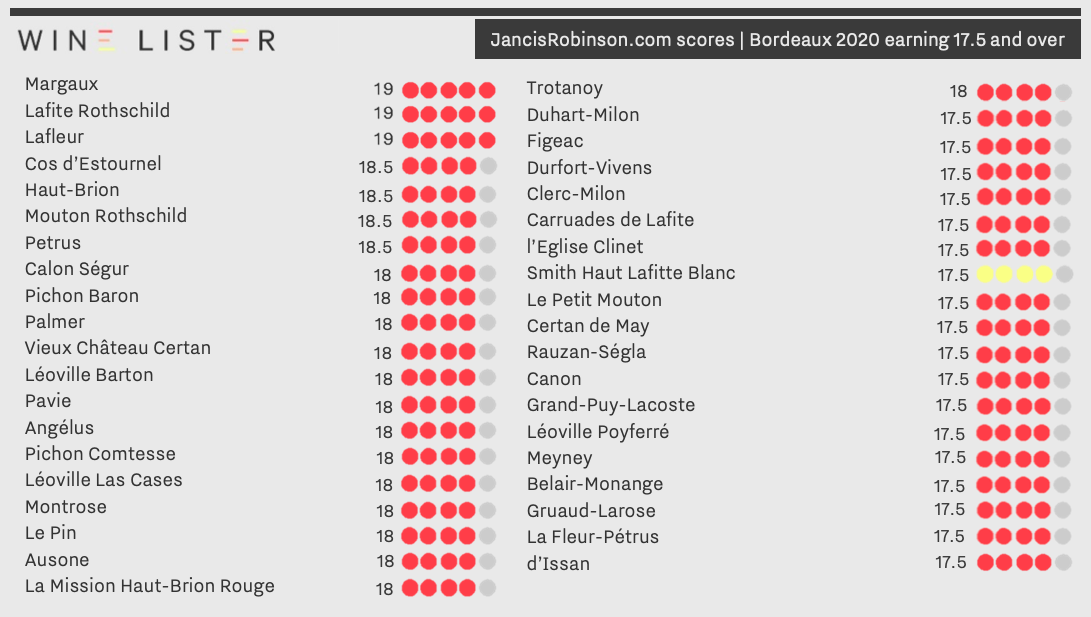
With a shared score of 19 from James Lawther for JancisRobinson.com, First Growths Margaux and Lafite lead the pack alongside Pomerol’s beloved Lafleur. Lawther describes Margaux 2020 as “aromatically complex with floral, mineral and dark-fruit notes”, and notes that Lafite 2020 is “rich, but with a massive charge of fine-grained tannin and lingering freshness” on the palate.
Fellow First Growths Haut-Brion and Mouton follow shortly after with a score of 18.5, shared with Lafleur’s neighbouring property, Petrus, and Saint-Estèphe staple, Cos d’Estournel.
Pomerol represents eight out of the 39 wines earning 17.5 and over from the JancisRobinson.com critics, recalling sentiments that earlier-ripening Merlots fared best in the latest vintage. Joining Lafleur and Petrus, Vieux Château Certan, Le Pin, Trotanoy, l’Eglise Clinet, Certan de May, and La Fleur-Pétrus earn a score of 17.5 for their 2020s.
Smith Haut Lafitte Blanc is the only dry white Bordeaux to gain a score of 17.5 and above from JancisRobinson.com critics so far. Robinson tasted the wine herself, and observes that it is “already gorgeous” with “some richness on palate entry” that “gives way to really fantastic vibrancy on the palate”.
Also featured in the list of Bordeaux 2020s earning 17.5 and over from Wine Lister partner critic platform, JancisRobinson.com are: Calon Ségur, Pichon Baron, Palmer, Léoville Barton, Pavie, Angélus, Pichon Comtesse, Léoville Las Cases, Montrose, Ausone, La Mission Haut-Brion Rouge, Trotanoy, Duhart-Milon, Figeac, Durfort-Vivens, Clerc-Milon, Carruades de Lafite, Le Petit Mouton, Rauzan-Ségla, Canon, Grand-Puy-Lacoste, Léoville Poyferré, Meyney, Belair-Monange, Gruaud-Larose, and d’Issan.
Explore the top Bordeaux 2020 scores from Bettane+Desseauve, Neal Martin and Antonio Galloni (Vinous), and Jeannie Cho Lee.
The majority of Bordeaux 2020 en primeur scores have now been published by Wine Lister partner critic, Bettane+Desseauve, offering further insight into some of the best bottles from the latest vintage.
Explore all Bordeaux 2020 WL scores here, or read more below.
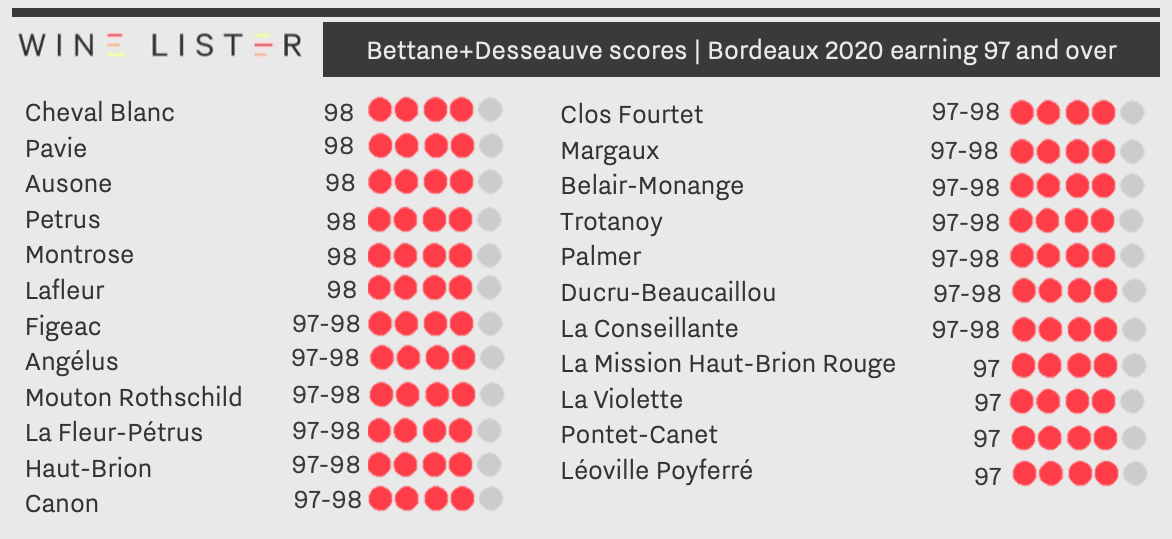 Note that this year Bettane+Desseauve’s scores are officially ranked on a 100-point scale, as shown above. For consistent and comparable analysis with previous vintages, Bettane+Desseauve have provided 20-point scores to be displayed on individual Wine Lister wine pages during the transition into their new system.
Note that this year Bettane+Desseauve’s scores are officially ranked on a 100-point scale, as shown above. For consistent and comparable analysis with previous vintages, Bettane+Desseauve have provided 20-point scores to be displayed on individual Wine Lister wine pages during the transition into their new system.
Five of the six wines that receive a score of 98 from Bettane+ Desseauve this year hail from the Right Bank, with Cheval Blanc, Pavie, Ausone, Petrus, and Lafleur leading the list. This adheres to initial indications that it is a Right Bank year, with earlier-ripening Merlot, partnered with the soil’s increased water-holding capacity, helping it handle the drought during the summer.
Indeed, a further five wines on the list come from Saint-Emilion, whose limestone terroirs encouraged a steady water table for the vines in 2020. Figeac, Angélus, Canon, Clos Fourtet, and Belair-Monange all score an impressive 97.5 with their latest vintages.
Pomerol also provides a further four picks, with La Fleur-Pétrus, Trotanoy, and La Conseillante gaining 97.5, followed by micro-production La Violette (releasing 4,800 bottles in 2020) with 97 points.
Also featured on the list of Bordeaux 2020s earning 97 and over from Wine Lister partner critic, Bettane+Desseauve are: Mouton Rothschild, La Fleur-Pétrus, Haut-Brion, Margaux, Palmer, Ducru-Beaucaillou, La Mission Haut-Brion, Pontet-Canet, and Léoville Poyferré.
Explore the top Bordeaux 2020 scores from JancisRobinson.com, Neal Martin and Antonio Galloni (Vinous), and Jeannie Cho Lee.
With the 2020 en primeur campaign now in full swing, the past two days have seen releases from the likes of Angélus, the Barton family, the Perse family, and more.
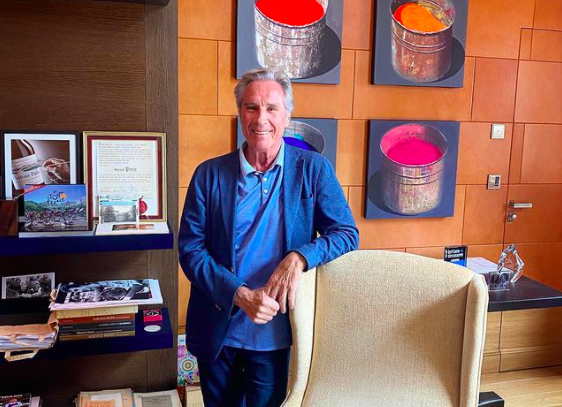 “Another big step in the right direction for this château in revealing its excellent terroir” – Wine Lister, CEO Ella Lister, who visited Pavie’s owner, Gérard Perse (pictured) last year
“Another big step in the right direction for this château in revealing its excellent terroir” – Wine Lister, CEO Ella Lister, who visited Pavie’s owner, Gérard Perse (pictured) last year
Released yesterday morning (Tuesday 18th May), the latest vintage of the Barton family wines – Léoville Barton, Langoa Barton, and Mauvesin Barton – has reportedly seen a positive uptake in the UK market already. Wine Lister partner critic, Jancis Robinson, gives high praise to the flagship release, Léoville Barton, awarding it 18 points, and noting that it shows “very fine winemaking indeed”, adding, “I have to admit I was tempted to swallow this, it was so majestic”. Wine Lister’s CEO, Ella Lister, also commends the latest vintage, describing a “sculptured structure which takes it into a different register”. The 2020 was released at £60.80 per bottle in-bond – over 10% higher than last year’s release, but potentially sporting the wine’s best quality to date.
Two more Saint-Émilion Grand Crus Classés “A” have joined fellow comrade and early-bird release Cheval Blanc, with Angélus entering the market at £254 per bottle (in-bond), and Pavie following closely behind at c.£241 per bottle (in-bond).
The latter gained resounding praise this year: James Lawther (for JancisRobinson.com) notes “absolute precision” which he says “more than highlights the change in style,” concluding, “one of the best yet”. Ella echoes this sentiment, asserting that “delightful floral freshness and a feather-light texture mark another big step in the right direction for this château in revealing its excellent terroir,” and calling the wine ”complex and refined”. The comments combined suggest that Pavie 2020 is the culmination of stylistic changes undertaken by the property over the last few years.
Perse family sibling, Pavie-Decesse 2020 was also released yesterday at £83 per bottle (in-bond). The latest vintage gains 17 points from James Lawther, who describes “Tension and minerality as well but plenty of charm this year”. With virtually no stocks of last year’s release remaining on the market, and the estate offering an element of rarity (at 3.5ha, it is a 10th of the size of Pavie), the latest release is likely to gain appeal beyond its volume released.
Also released so far this week are: Marquis d’Alesme, Labégorce, Coutet, Guiraud, Bellevue-Mondotte, and Monbousquet.
As the fine wine industry starts preparing for another Bordeaux en primeur season at a distance, Wine Lister has published Part I of its annual in-depth Bordeaux Study. With insights from key fine wine trade players from across the globe, Part I evaluates Bordeaux’s recent performance, considers the major takeaways from the 2019 vintage campaign, and contemplates the lessons they might provide moving forwards.
Please see our key findings below:
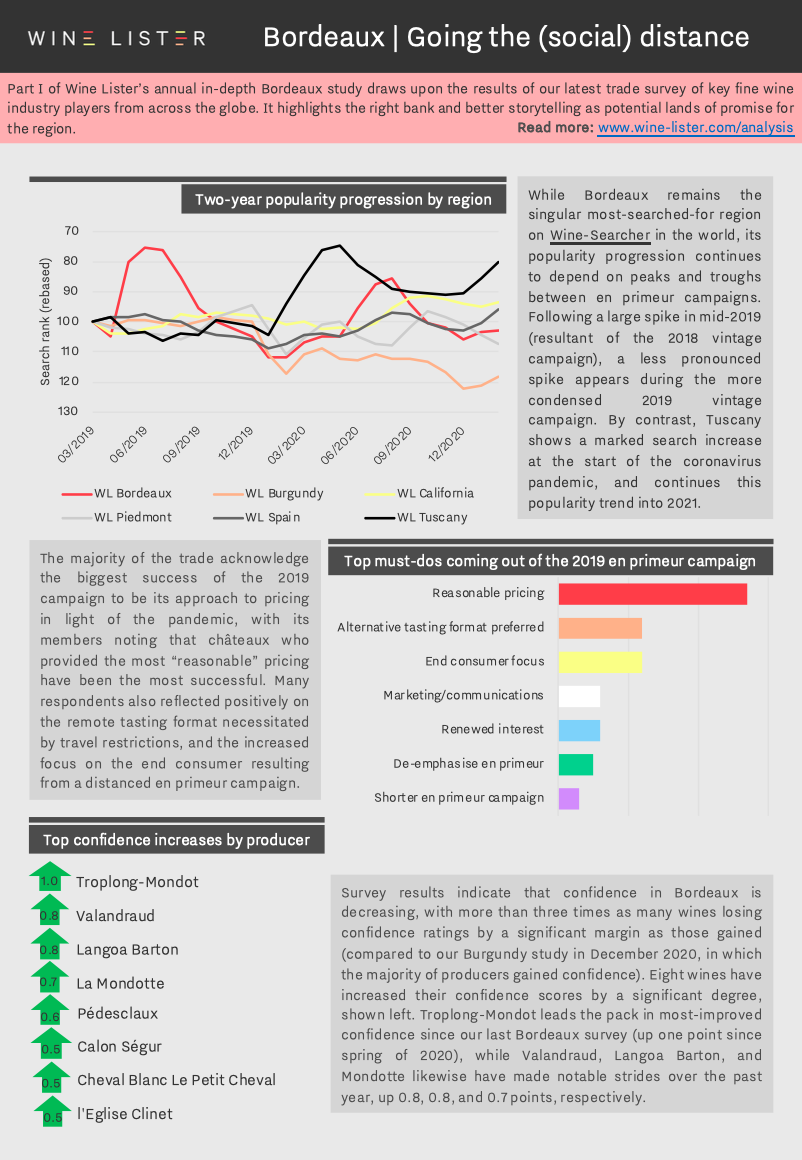
You can download the study digest in English here: Wine Lister 2021 Bordeaux Study – Digest or French here: Wine Lister 2021 Bordeaux Résumé d’étude. The full report can be purchased on our Analysis page, while Pro subscribers can access their free copy here.
With the bank holiday weekend approaching, Wine Lister has selected 10 mature Bordeaux MUST BUYs that promise to please with your Easter Sunday lunch. Boasting at least nine years of ageing, these top picks are available to purchase for under £100 (per bottle in-bond, when purchasing by the case in general).
Check out all of our Bordeaux MUST BUYs here, or read more below.
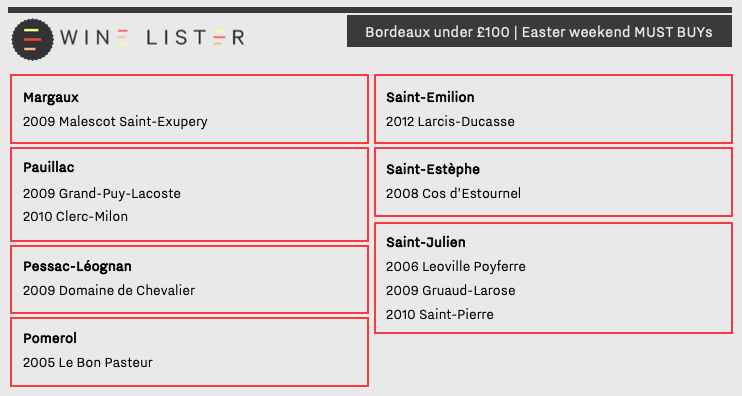
Regarded as a top-quality year for Bordeaux across appellations four of the 10 MUST BUY picks hail from 2009. Following a wet spring that provided plentiful water reserves, the summer of 2009 saw almost perfect growing conditions with minimal disease pressure, and many great wines from the vintage are beginning to either their optimum drinking window.
Described by Wine Lister partner critic, Jancis Robinson, as “very winning and opulent” with “massive volume and finish”, Margaux’s Malescot Saint-Exupery achieves a WL score of 93 in 2009. The property has exhibited an upward quality trajectory since the turn of the century, with the legendary Michel Rolland consulting on its production of a single, unfiltered and unfined wine. The 2009 vintage can be purchased from Fine+Rare for £71 per bottle (in-bond).
Grand-Puy-Lacoste’s 2009 vintage receives 18 points from Robinson, who notes; “a very sweet start. Herbal and interesting. Lots of fine tannin and savour. Very distinctive and ambitious”. Marking the estate’s highest WL score since its 1990 vintage (94), the 2009 is available to purchase from Bordeaux Index for £59 per bottle (in-bond).
Another classic left bank brand, Gruaud-Larose’s 2009 is described by Wine Lister partner critic, Neal Martin (Vinous), as offering refined aromas of “blackberry, cedar and leather”, and a “fine bead of acidity [with] great precision on the brown spice infused finish”. Hailed for the longevity of its wines, this can be enjoyed now, or aged for at least 10 more years. It is available from Bordeaux Index for £81 per bottle (in-bond).
Moving across to the right bank and back a few vintages, 2005 Le Bon Pasteur achieves the property’s highest ever WL score (94), and is described by Wine Lister partner critic, Bettane+Desseauve as offering notes of “dark fruits and fine chocolate”, and a “refined tannic structure, brilliant length and freshness”. With over 15 years of age, and only 2,500 bottles released, it has limited remaining market availability, but can be sought out for £100 per bottle (in-bond) from Cru World Wine.
Slightly south in Saint-Émilion, our chosen younger offering from Larcis-Ducasse – the 2012 – is available from Cult Wines for £41 per bottle (in-bond), making it the least expensive of the group. While rain in October forced many left bank estates to pick their late-ripening Cabernet Sauvignon earlier, the predominance of Merlot on the right bank saw its wines perform comparably better in 2012. Wine Lister partner critic, Jeannie Cho Lee, describes the 2012 Larcis-Ducasse as an “elegant, full bodied red with opulent tannins and wonderful energy”.
Last but not least, Saint-Estèphe star Cos d’Estournel makes the cut for its 2008 vintage. Robinson describes it as “very luscious and round” with a “strong blackcurrant element” and “surprisingly gentle tannins”. Achieving a WL score of 94, it is available to purchase by the bottle from Lay & Wheeler for £88 (in-bond).
Having commenced the week with International Women’s Day (Monday 8th March), Wine Lister’s latest blog celebrates some of the leading female figures in winemaking. Interviewing a handful of top producers across six regions, whose practices embody a range of principals, we put a spotlight on the wines made by some of the industry’s most exceptional women.
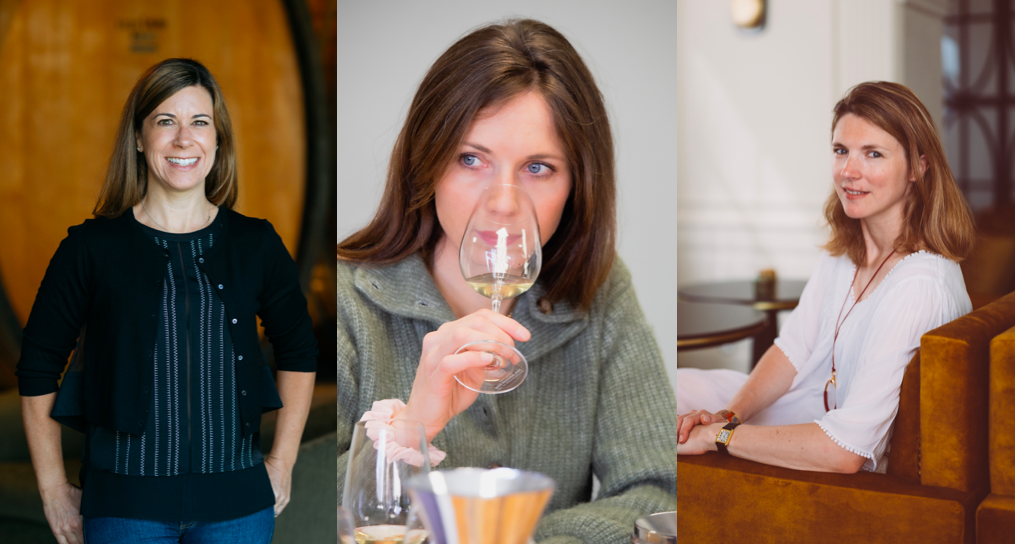 From left: Ashley Hepworth, Caroline Frey, and Stéphanie de Boüard-Rivoal
From left: Ashley Hepworth, Caroline Frey, and Stéphanie de Boüard-Rivoal
Ashley Hepworth – Joseph Phelps Vineyards
Following a degree in Chemistry and Biology, Ashley Hepworth spent two years cooking at Charlie Trotter’s legendary Chicago restaurant, where she realised she “wanted to learn more about wine and utilize [her] science background”. After studying the restaurant’s wines, and quizzing its Master Sommeliers, she applied for a harvest internship at Joseph Phelps where she continued to work her way “up the ladder”, eventually becoming winemaker in 2008. She is “particularly fond” of the 2008, 2015, and 2017 vintages of Joseph Phelps’ flagship wine, Insignia, explaining that each are “distinctive of the given vintage and the interplay of the six estate vineyards” that the wine is blended from.
Caroline Frey – La Lagune and Paul Jaboulet Aîné
Having taken the helm of third-growth property La Lagune from her father in 2004, Caroline Frey has since assumed an additional winemaking role in the Rhône, at Paul Jaboulet Aîné, after its acquisition by her family in 2005. Like several of the producers we spoke to, Caroline informs us that working “in harmony with nature is a long-term project” for her, with both properties now certified biodynamic. She explains that “to produce great wine the grapes must be the fruit of nature and not of synthetic chemistry”, and the more she “improves in working in harmony with nature” the “more wonderful” her wine will be.
Stéphanie de Boüard-Rivoal – Angélus
Having spent her childhood at Angélus, Stéphanie de Boüard-Rivoal was seven years old when she told her grandfather, Jacques de Boüard de Laforest, that she wanted to join him and her father, Hubert, in running the estate. After an early career in London’s financial sector, Stéphanie returned to Angélus in 2012, and has since continued a “quest for excellence while endeavouring to keep the estate in [her] family”. Noting “purity, tension, and focus” as key words to describe the style of her wine, she tells us that she is currently fond of Angélus’ 2005 and 2010 vintages, and anticipates enjoyment of the 2016 and 2018 in the coming years.
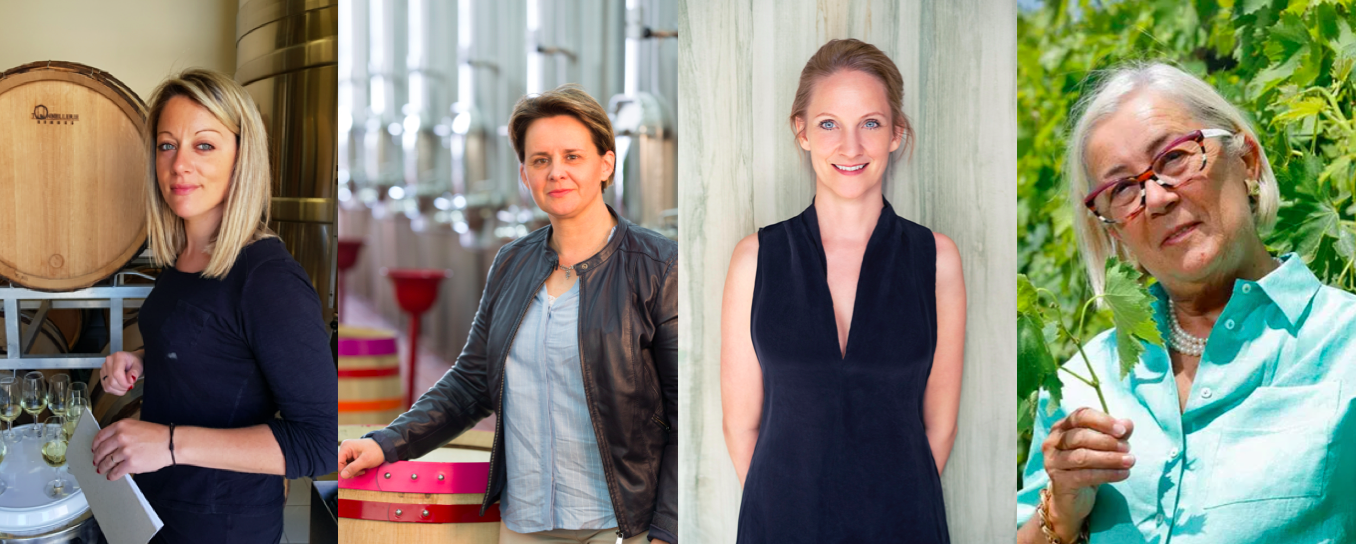 From left: Charlène Pinson, Florence Heresztyn-Mazzini, Eva Fricke, and Donatella Cinelli Colombini
From left: Charlène Pinson, Florence Heresztyn-Mazzini, Eva Fricke, and Donatella Cinelli Colombini
Charlène Pinson – Pinson
One of the longest-established families in Chablis, records show that the Pinsons have been producing in the region since 1640. Having joined her father, Laurent, at the estate in 2008, Charlène Pinson tells us of her respect for tradition and the work that her family has done before her, with the aim to “pass on the passion” to her two sons. Producing 13 different wines, she explains that each is a “reflection of their terroirs”, and are “more or less floral and fruity” depending on the slope and soil of the parcel. For those new to Pinson, she recommends the 2017 Chablis Mont de Milieu, describing it as a “pure expression of our Kimmeridgian limestones […] classic, mineral, balanced, and fresh”.
Florence Heresztyn-Mazzini – Heresztyn-Mazzini
Taking over her family’s estate (Domaine Heresztyn) in 2012, Florence Heresztyn-Mazzini and her husband, Simon Mazzini have overseen numerous developments under its new name. Introducing biodynamic practices in 2015, and achieving organic certification in 2019, Florence continues to “experiment with natural treatments” to fulfil her goal of “fighting the challenges of climate change”, including more “cover crops and sustainable pruning”. Explaining that many recent vintages have been difficult due to global warming, she tells us that she is particularly proud of her “fights” in 2013 and 2016, creating top quality wines in years that “remind us that we are small in the face of Mother Nature!”.
Eva Fricke – Eva Fricke
After making wine in Australia, Spain, and Germany, Eva Fricke returned to Germany in 2006 to start her own estate, which now holds 17ha across the Rheingau. Achieving organic certification in 2016 and membership in The Vegan Society in 2017, the property also employs several biodynamic practices including its adherence to the lunar calendar. She tells us that these principals guide her goals of developing a domain that “stands for organic, sustainable, and socially conscious standards”. Eva notes the “2019 Lorcher Schlossberg, 2019 Lorcher Krone Trocken, and 2019 Lorcher Krone Trockenbeerenauslese” as some of her top wines.
Donatella Cinelli Colombini – Casato Prime Donne and Fattoria del Colle
Born into a family of winemakers whose production in Montalcino can be traced back to 1592, Donatella Cinelli Colombini tells that it is “for this reason” that winemaking comes naturally to her. Founding Italy’s first winery run solely by women, she explains that her decision to have an all-female staff at Casato Prime Donne “leaves an imprint of acute accuracy in each step of the production process”. She notes of Casato Prime Donne wines that they are some of the first “chosen, and produced by women, for women”.
If ever there is a time for claret, it’s Christmas. While Bordeaux generally provides excellent quality for its prices relative to other regions all year round, it is an especially good source for festive bottles with a bit of age. Below Wine Lister offers one MUST BUY under £100 per Bordeaux appellation – a selection that promises to please with your Christmas meal.
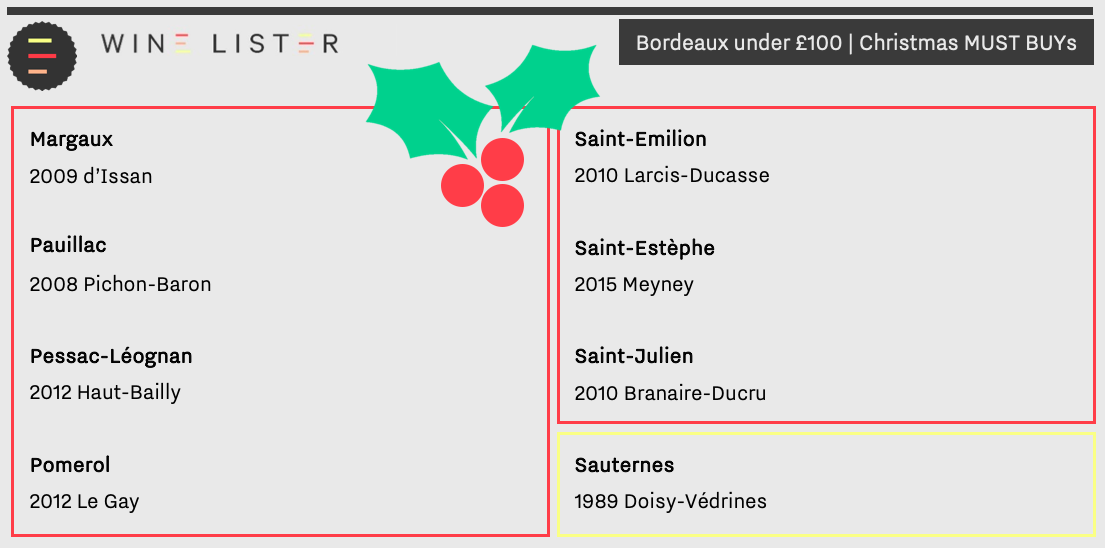
Aside from its lustrous gold label providing an appropriate centrepiece to any festive feast, d’Issan 2009 offers good value for its appellation, earning a WL score of 93 at £56 per bottle (in-bond). Château owner, Emmanuel Cruse, is also the “Grand Maître” of the Commanderie du Bontemps – a Bordeaux organisation uniting trade members in the preservation of Bordeaux’s excellent quality reputation. D’Issan embodies the values of its maker, exemplifying the traditional claret style with added Margaux elegance. It is available to purchase by the case of 12 from Nickolls and Perks.
Pauillac powerhouse Pichon-Baron 2008 is described by Wine Lister partner critic, Neal Martin (Vinous), as one of the property’s “overachievers in recent years”. Often noted for being one of the most concentrated wines of the vintage in its appellation and beyond, Martin writes that the 2008 is “full of tension and energy […] delivering real brightness and vivacity on the finish”. At £90 per bottle (in-bond), it is the most expensive wine featured in this article, however, its Second Growth status and an abundance of critics’ praise make it worthy of consideration. Pichon-Baron 2008 can be acquired by the case from Lay & Wheeler.
A top-quality substitute to some of Haut-Bailly’s more costly back vintages, the 2012 achieves the property’s second-best WL score ever, as well as second place for quality among Pessac-Léognan reds for the vintage. Wine Lister partner critic, Antonio Galloni (Vinous), states that “the decision to lower temperatures in fermentation and go for a soft, gentle extraction, along with strict selection has paid off big time” in 2012, revealing notes of “dark raspberries, mint, crushed flowers, spices and rose petals”. Haut-Bailly 2012 is just entering its drinking window, and can be bought from Cru Wine.
Finding value on Bordeaux’s right bank can be trickier, particularly in Pomerol. Le Gay 2012 nonetheless offers excellent quality (WL 94) for the relatively reasonable price of £61 per bottle (in-bond). Wine Lister partner critic, Jancis Robinson, notes that it reaps “real Pomerol reward in terms of concentration”, offering a “very well-integrated nose […] sweet and focused”. In neighbouring Saint-Emilion, Larcis-Ducasse 2010 is described as “simply stunning” by Antonio Galloni, who notes “violet, lavender, graphite and menthol” that “give the 2010 its energy and tension”. It gains a WL score of 94, at £87 per bottle (in-bond). Both of these right bank picks can be purchased from Cult Wines.
Achieving Value Pick status, Saint-Estèphe’s Meyney 2015 has a WL score of 93 at £25 per bottle (in-bond), providing a veritable steal for your Christmas meal. After sampling at the annual Southwold Bordeaux tasting, Neal Martin writes that it “was the shock of this blind tasting – in a positive sense […] I thought it might be Montrose but it turned out to be Meyney. Chapeau!” Though the 2015 could benefit from a few more years of ageing, it is a brilliant gift option for your more patient guests, and can be acquired from Goedhuis & Co.
Saint-Julien star, Branaire-Ducru’s 2010 vintage was described as “dancing” by Jancis Robinson. Neal Martin’s tasting note suggests a wine of complexity: “a lovely mélange of red and black fruit, hints of dried blood and autumn leaves suggesting that this is moving into its secondary phase”. With a WL score of 93, Branaire-Ducru 2010 can be purchased by the case of 12 from Farr Vintners for £52.50 per bottle (in-bond).
For a sweet end to your Christmas meal, Wine Lister suggests Doisy-Védrines 1989. With 30 years of ageing under its belt, it achieves a WL score of 94 – the château’s highest ever. It is described by Neal Martin as boasting “a captivating bouquet of gorgeous wild honey, Seville orange marmalade, fig jam and light lemongrass scents”. He adds, “it is simply everything you desire in a sweet Bordeaux”. Purchase Doisy-Védrines 1989 by the bottle from Hedonism Wines for £62.80 (in-bond).
As well as marking the year that France won the World Cup Final, 2018 will be remembered in Bordeaux as a tumultuous growing season, starting with nightmare weather conditions, and finishing “in ecstasy” (recap more on the 2018 vintage in Wine Lister’s post-harvest and vintage assessment blogs).
Now that the wines have settled in bottle, it is the world around them that has been thrown into a state of chaos, though one managed impeccably by the organisers of Wednesday’s UGC tasting (see photo below). Tasting around 130 wines, members of the Wine Lister team have chosen a selection of highlights, as examined in this post.

The team’s highlights include seven of the 19 Bordeaux 2018s MUST BUYs, and 11 other picks that were showing the best out of those present at the UGC tasting.
Pauillac and Pessac-Léognan were our top two appellations, with four picks apiece. The two Pichons – Baron and Comtesse – were showing beautifully, the former impressing with a “ripe, autumn berry profile” and a “dense but silky texture”. Pichon Comtesse – one of Wine Lister’s favourites during 2018 en primeur tastings – exhibited toasty notes of “tobacco, coffee, and mocha” on the nose, that opened into an elegant and energetic palate of “black cherry with chai spices”.
In Pessac-Léognan, Domaine de Chevalier presented subtly at first, but opened up into a “heady nose of plum and cassis”, matched with an equally sumptuous palate that was “deep in tone, but lifted in structure”. Malartic-Lagravière displayed a distinct Pessac minerality, and featured an intense, perfumed nose of “morello cherry and lavender”. The palate showed more savoury flavours, nonetheless endowed with a “velveteen texture”.
Elsewhere on the left bank, Margaux had three highlights, including the “sensual and floral” Giscours, and Brane-Cantenac – a “powerball of ripe, layered, and energetic fruit”. MUST BUY Rauzan-Ségla displayed nuanced aromas of “blueberry and raspberry”, with a notably generous and glossy mouthfeel.
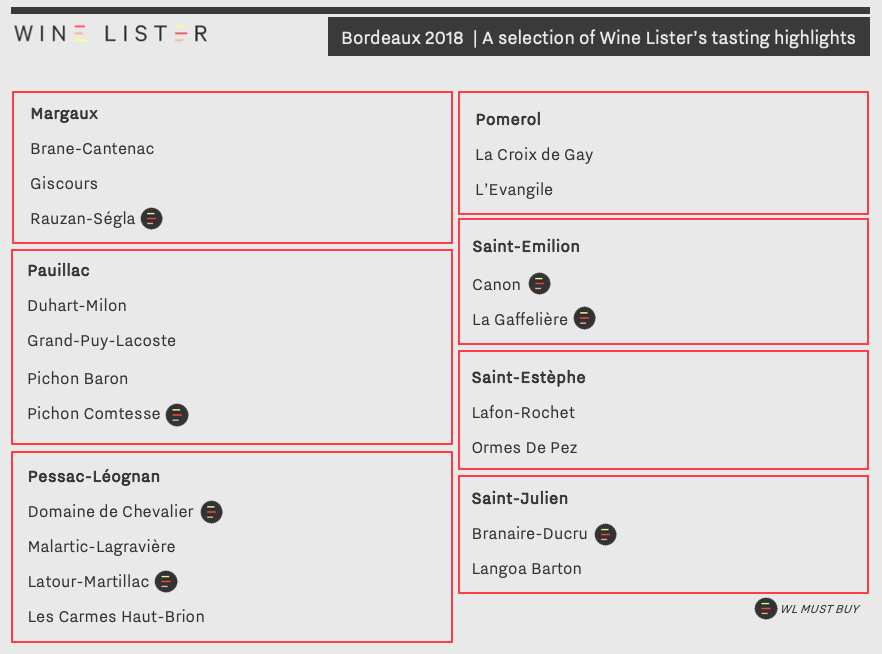
Both Saint-Estèphe highlights offered complex profiles, sharing a comparable first note of “smoke and cured meats”. Lafon-Rochet prevailed in savoury finesse, opening up into “sandalwood and black pepper” on the nose, while Ormes De Pez developed into a “sweet and plummy” bouquet, providing “crunchy red apple and bramble” on the palate.
In Saint-Julien, MUST BUY Branaire-Ducru 2018 showed at the same time a “welcoming warmth” and a plethora of pure and precise fruit notes; “blackcurrant, blackberry, red plum” and a long, floral finish.
On the right bank, Saint-Emilion was well-represented by Canon 2018, which the Wine Lister team noted as “multi-dimensional”, encompassing an opening minerality that swiftly released into a refreshing bouquet of “luscious cherry, raspberry, and crushed strawberries”. Its palate was “utterly moreish”, with “delicate cherry notes” lingering on the finish – “this just goes on and on”, we noted.
In Pomerol, La Croix de Gay stood out with a distinct, potpourri character on the nose, and an “elegant palate of ripe berries”. L’Evangile, displayed a wealth of “black fruit flavours, overlaying its rich but balanced mouthfeel”.
Other wines included in Wine Lister’s 2018 tastings highlights are: Duhart-Milon, Grand-Puy-Lacoste, La Gaffelière, Langoa Barton, Latour-Martillac, and Les Carmes Haut-Brion.
Despite this year’s unparalleled circumstances, mother nature has had no choice but to persevere – members of the Wine Lister team visited Bordeaux during September, to get a feel for the 2020 harvest. After a turbulent nine months, 2020 has reportedly yielded another excellent vintage for Bordeaux, though the region’s vines experienced their own set of ups and downs. Outside of its macro-economic turmoil, 2020 proved an uncertain growing season too, as microclimatic weather patterns appear to have been more influential than ever. Small areas on both banks experienced hail, and rainfall differed by hundreds of millimetres from one property to the next. With a bit of luck, this is a vintage the international trade will be able to taste by next spring – and it will need tasting, in order to gain a comprehensive understanding of the best examples of the vintage.
Common to several properties was an early start to harvest, with masked pickers dispersing across many vineyards up to two weeks ahead of a “normal” year. Indeed, Pavie began harvesting its white grapes (for Monbousquet Blanc) at the end of August – a fortnight earlier than last year. Merlot grapes began to be collected on the 21st of September – nine days earlier than in 2019 (pictured below on the 22nd September).
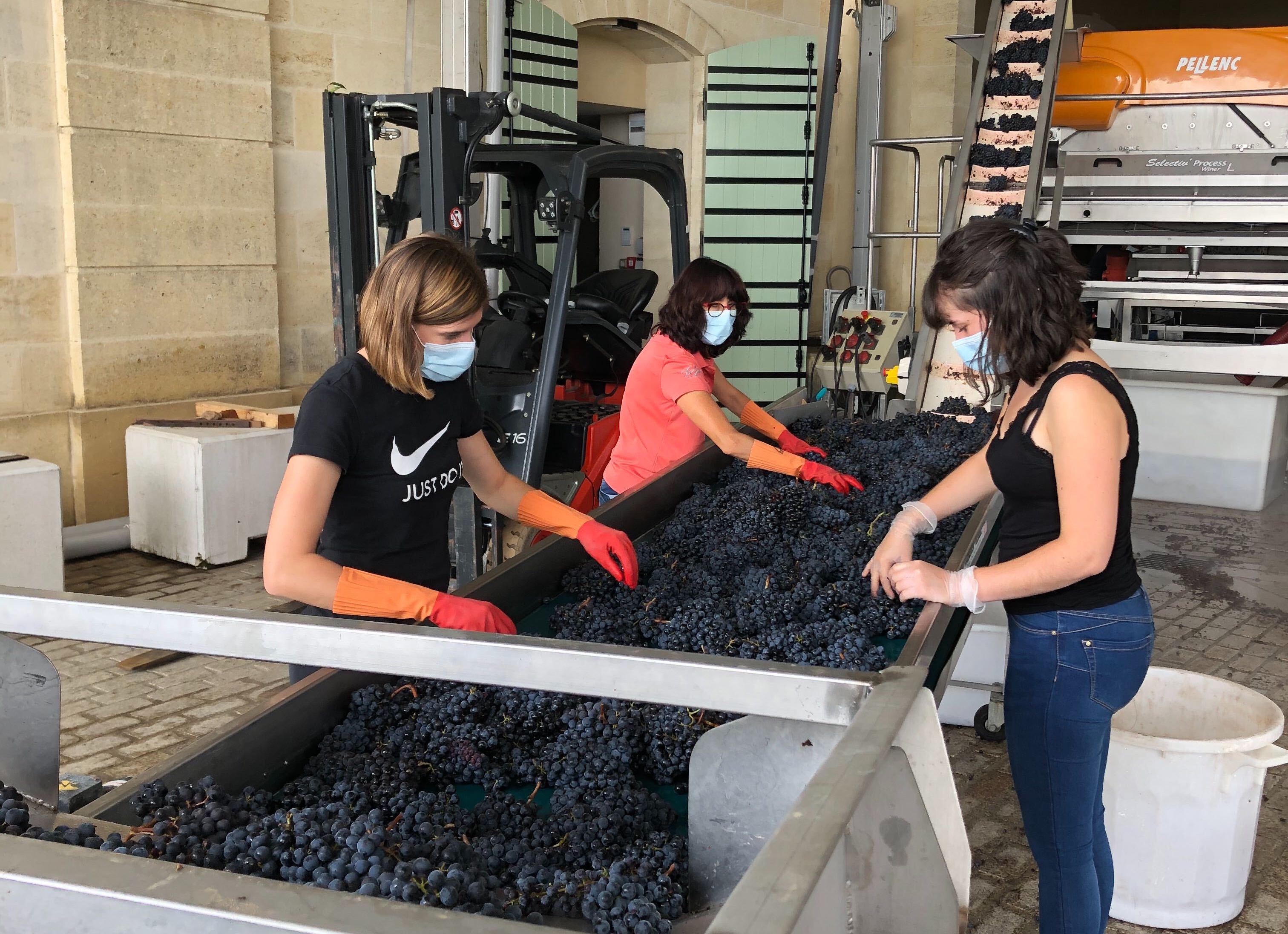 Masked workers sort Pavie’s 2020 Merlot grapes (22nd September 2020)
Masked workers sort Pavie’s 2020 Merlot grapes (22nd September 2020)
Pavie saw lower rainfall in 2020 than parts of the Médoc. The position of its vineyards at higher altitude on the south-facing slope of its renowned limestone plateau allows for both phenolic maturity and the retention of freshness. Its new Commercial Director, Olivier Gailly, notes that the mid-harvest showers also helped with the latter, freshening up the Cabernets prior to picking, and that subsequent high wind speeds dried the grapes, and prevented mildew from setting in.
Just a few kilometres north-west, Saint-Émilion star Angélus did not have a particularly early harvest in 2020, starting on the 15th of September – just three days earlier than last year. The estate saw mildew at the beginning of the season, which they managed to control ahead of a good flowering. Eighth-generation manager, Stéphanie de Boüard is confident in the new vintage, aligning it with the iconic 1947 or 2010 – “my father told me not to be ashamed to say it”, she notes of the comparison. Early analyses show the 2020 will likely be high in alcohol, but with a low pH, creating a freshness and an overall balance that was encouraged by mid-harvest rain. “This year picking dates have been more important than ever”, she adds, referring to the retention of fresh fruit, as opposed to more cooked aromas than can occur in warmer Bordeaux vintages.
Further north-west still in Pomerol, Beauregard also received much-needed rain during harvest, which similarly helped to soften the skins of its Cabernet grapes. Summer drought was more apparent here, repeating the 2018 phenomenon of hydraulic stress on the vines, and resulting in a smaller yield than 2019.
Moving to the Médoc, more properties saw the same hot and dry climatic conditions in 2020, resulting in instances of small grapes with high alcohol potential and lower acidity. In Margaux, d’Issan saw 16% potential alcohol in some of its early Merlot grapes (the highest ever recorded), and consequently welcomed the mid-September showers. Neighbouring Palmer anticipated the rain, and held off picking its Cabernet Sauvignon grapes until it came and went, ensuring the thinning of skins on smaller berries, and an overall reduction in alcohol percentage. The estate saw limited yields due to the dry summer, and Managing Director, Thomas Duroux, quipped that although “négociants would have liked a vintage with high volume and lower prices, [2020] will be a small vintage…” While he implies it might be more expensive than the trade had hoped, he nonetheless expects the 2020 to be “rich and exuberant”, sharing the power and concentration of 2018.
In Saint-Julien, owner of Branaire-Ducru, François Xavier Maroteaux describes a 2020 growing season of neat balance. The estate had a “wet post-harvest Autumn in 2019”, which helped to prevent drought stress throughout the new growing season. As the summer began to dry out, the estate saw 100 millimetres of rainfall in a short period (at the end of August), followed by a sunny and warm September. The season itself, Maroteaux muses, is similar to the 2011 vintage. He believes the resulting wine is worth excitement, after a steady and successful ripening, avoiding any disease.
In Pessac-Léognan, Malartic-Lagravière expects a concentrated wine in 2020, having also seen low volumes of mainly small berries due to the heat. Neighbouring Domaine de Chevalier echoed the sentiment, and we were surprised to hear from owner, Olivier Bernard, that there had not been a drop of rain at estate the day before our first visit (21st September), despite it raining throughout the same day in the Médoc, and in Bordeaux itself.
 The last day of picking at Domaine de Chevalier (30th September 2020)
The last day of picking at Domaine de Chevalier (30th September 2020)
“There have been lots of choices to make this year”, he continues – one of which no doubt was whether to trust the weather forecasts, particularly around harvest. With fewer planes flying around, forecasts were less accurate, and while rain fell further north, Pessac often remained dry. Bernard explains that the picking windows were tight in 2020: “instead of four days where the grapes are fine to pick, there’s one day” – since the drought and heat would cause alcohol to rise, and acidity to deplete quickly.
It seems therefore that we have another winemaker’s vintage on our hands. Mirroring somewhat the choppy commercial seas of this year, Bordeaux has had to navigate unpredictable viticultural waves too. What we have heard of the 2020 harvest thus far nonetheless leaves us hopeful, and anticipating eagerly the en primeur tastings of next spring.
Thanks to solid discounts on existing market prices from many châteaux, the Bordeaux 2019 en primeur campaign can be considered a success, and may prove in the long-term to have helped the en primeur system find its feet once again, in terms of the cost benefit it offers to buyers.
Part II of Wine Lister’s Bordeaux Study, In sickness, in health discusses this in more detail. In the meantime, below we have selected top MUST BUYs at different price points, to help those still on the hunt for Bordeaux 2019.
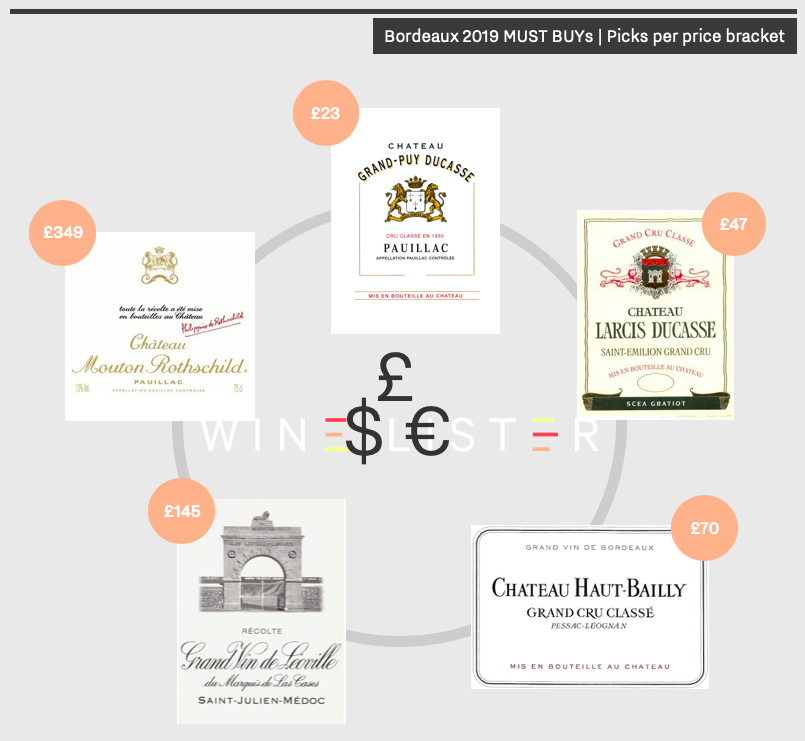
Under £25 – Grand-Puy-Ducasse
Grand-Puy-Ducasse 2019 is both a MUST BUY and a Value Pick, achieving its best ever WL score of 93 in 2019, available at £23 per bottle (in-bond) when buying by the case. The latest release illustrates the contrasting climatic conditions of 2019, with critics noting its complexity and nuance. Wine Lister partner critic, Neal Martin, notes, “crisp tannins, a fine bead of acidity, cohesive and harmonious with a lovely saline/briny note”, adding “this is one of the best Grand Puy Ducasse wines that I have encountered from barrel. Excellent”. Grand-Puy-Ducasse 2019 is available to purchase by the case from Justerini & Brooks.
More Bordeaux 2019 MUSY BUYs under £25: Capbern, Gloria, Laroque, Meyney, Potensac, and Siran.
Under £50 – Larcis-Ducasse
At £47 per bottle (in-bond), Larcis-Ducasse 2019 is priced notably well within the wider context of Saint-Émilion Grand Cru Classé “B” releases. As examined in a recent en primeur blog, it earns a WL score of 95 – just one point less than the likes of Cheval Blanc and Pavie (costing on average six times less than its Classés “A” neighbours). Winemaker, David Suire, observes that the vintage reflects clearly its limestone terroir, showing floral notes and an overriding minerality. Wine Lister partner critic, Antonio Galloni, concurs, noting “graphite, menthol, licorice, tobacco and cedar notes” in the bouquet, coining it “one of Bordeaux’s most under the radar gems”. While demand for this wine has likely been strong, Larcis-Ducasse 2019 is still available through Millésima’s UK and Hong Kong branches.
More Bordeaux 2019 MUST BUYs under £50: Brane-Cantenac, Giscours, Grand-Puy-Lacoste, La Gaffelière, Malescot Saint-Exupéry, and Pavie-Macquin.
Under £100 – Haut-Bailly
At £70 per bottle (in-bond), Haut-Bailly 2019 shares the château’s top WL score (95) with recent vintages 2018, 2016, 2015, and 2014. Managing Director, Veronique Sanders, told the Wine Lister team of their need to light fires five times to prevent frost in the spring of 2019, escaping unscathed. In the end, challenges throughout the growing season concluded in perfect harvest conditions, and a wine of impressive balance and energy. Indeed, the 2019 has received unanimous confidence from critics – Neal Martin states that the 2019 is a “more terroir expressive Haut-Bailly that has an effortless allure and a sense of sophistication”, concluding that it is “wonderful”. Haut-Bailly 2019 can be acquired by the case through Goedhuis & co.
More Bordeaux 2019 MUST BUYs under £100: Calon Ségur, Canon-la-Gaffelière, Canon, Clinet, Léoville Poyferré, Pontet-Canet, Lynch-Bages, Montrose, and Troplong-Mondot.
Under £200 – Léoville Las Cases
Léoville Las Cases 2019 achieves a WL score of 97, at £145 per bottle (in-bond). While volumes of the 2019 released onto the market were down 35% on last year, there is still some availability of this Saint-Julien super second, and we highly recommend getting your hands on some. Wine Lister’s CEO, Ella, describes it as “luminous and lyrical”, noting a bouquet of “English garden – raspberry blossom, cow parsley, fraises de bois, and then a deeper note of ripe cherries”. James Lawther for JancisRobinson.com is similarly impressed, awarding it 19 points and noting it as “one of the greats from this estate”. The latest vintage can be purchased through Fine+Rare.
More Bordeaux 2019 MUST BUYs under £200: Figeac, Haut-Brion, La Conseillante, La Mondotte, Le Petit Mouton, La Mission Haut-Brion, Palmer, Pichon Comtesse, and Vieux Château Certan.
Over £300 – Mouton
While the release price of this Pauillac Premier Cru, let alone the quality of its 2019, likely makes it one of the most popular buys of the campaign, there may still be opportunities to secure some en primeur. Released at £299 per bottle (in-bond), Mouton 2019 achieves a WL score of 97 – the second-highest score achieved by the château in recent years, following the 2016’s 98. Wine Lister’s CEO, Ella Lister, describes Mouton 2019 thus: “velveteen tannins, long and caressing”, recounting “complex, savoury flavours of graphite and slate intermingled with the generous fruit”. Farr Vintners still appears to have some availability of Mouton 2019 (albeit at a slightly higher price than its release).
More Bordeaux 2019 MUST BUYs over £300: Cheval Blanc, Lafite, and Lafleur.
French readers can find this blog in French translation on Le Figaro Vin’s website.
Wine Lister Pro members can read Part II of the Bordeaux study here. All free users can purchase the report for £125 from Wine Lister’s Analysis page (available in both English and French).












